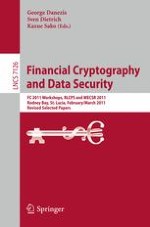This book contains the revised selected papers of the Second Workshop on Real-Life Cryptographic Protocols and Standardization, RLCPS 2011, and the Second Workshop on Ethics in Computer Security Research, WECSR 2011, held in conjunction with the 15th International Conference on Financial Cryptography and Data Security, FC 2010, in Rodney Bay, St. Lucia, in February/March 2011. The 16 revised papers presented were carefully reviewed and selected from numerous submissions. The papers cover topics ranging from anonymity and privacy, authentication and identification, biometrics, commercial cryptographic, digital cash and payment systems, infrastructure design, management and operations, to security economics and trust management.
